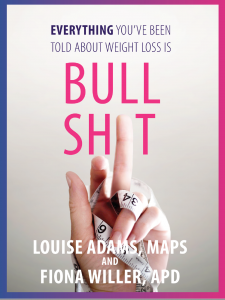|
Since the 1990’s, the weight loss industry has been pushing to have ‘o*esity*’ classified as a disease. This is the Holy Grail for pharmaceutical companies, because disease status opens the door to government and insurance subsidies, ensuring a steady pipeline of profits for their weight loss drugs. In spite of small wins – such as the American Medical Association’s decision to declare o*esity a disease in 2013- against the advice of its own committee– the industry’s campaigns have been mostly unsuccessful. In the absence of convincing evidence, governments and payers around the world have been understandably unwilling to allow huge swathes of the population to be declared ‘diseased’, foreseeing an unprecedented level of overtreatment. The sticky problem for the weight loss industry is that a lot of people with high BMI’s simply aren’t sick, and of course thin people can experience the same kinds of health problems that larger people do. Because the entire field of ‘o*esity’ research is BMI based, it’s fundamentally flawed. Using high quality NHANES data, research has demonstrated how shitty the BMI is – nearly half of people in the ‘overweight’ category of BMI and 29% in the ‘o*ese’ category were metabolically healthy, while 30% of those in the ‘healthy weight range’ were cardiometabolically unhealthy. The fact is, anthropomorphic features can’t tell us much about health: for that we need to conduct an actual health check. The failure of BMI to deliver disease has plagued the o*esity research community and their main sponsors: profit-hungry weight loss companies, who desperately need disease status in order to sell their drugs. Over the years this has led to elaborate efforts to diagnose ‘weight-related ill health,’ such as the Edmonton O*esity Staging System, (EOSS, 2009). This was dreamed up by Dr Arya Sharma, a Canadian physician whose bromance with Novo Nordisk knows no bounds, and Robert Kushner, who continues to rake in hundreds of thousands of dollars in consulting and speaker’s fees, mainly from Novo Nordisk.
The EOSS encouraged physicians to assess health issues – such as blood pressure or family history of diabetes – and link them to a ‘stage’ of ‘o*esity-related illness’, paving a path to more ‘aggressive’, government-approved weight loss treatments. In practice, it’s ridiculous: under the EOSS, a 38 year old female with a BMI of 59, borderline hypertension and mild lower back and knee pain, would be diagnosed with ‘Class 3, Stage 1 o*esity,’ which I’m sure would be music to her ears. Meanwhile, a person with a BMI of 25 would be diagnosed with borderline hypertension and mild lower back and knee pain, and receive actual health care without the side salad of medical weight bias. The EOSS has never caught on, because it’s obsolete – proper health care means that providers already assess (and treat) their patient’s health issues, without needing to tie everything back to fanciful weight-related ‘illness stages’. In 2017, a joint position paper from the American Association of Clinical Endocrinologists (AACE) and American College of Endocrinology (ACE) further exposed the failure of BMI based research. They admitted that the relationship between BMI-defined ‘o*esity’ and health was ‘obscure,’ and that weight stigma had worsened, not improved, following the AMA’s declaration of o*esity as a ‘disease’. Rather than binning the BMI, they proposed a new diagnostic: ‘adiposity-based chronic disease,’ or ABCD (if you say it fast, it sounds like ahh-bee-see-dee, how clever!????). Adiposity is a fancy term for fat cells, so the new idea was to focus on allegedly disease-causing fat cells. The location of fat cells, in their opinion, provided the ‘smoking gun’ for a disease state, but even here, it’s a case of #notallfatcells: butt and thigh fat actually protect against issues like insulin and cardiometabolic risk, whereas fat in the abdomen, around and inside organs, can ‘drive events that lead to metabolic syndrome, increased body weight, vascular inflammation, heart disease, and cognitive changes, eventually causing a complex medical state that conceals the initial problems with fat deposition.’ In 2019 the European Association for the Study of O*esity (EASO)– sponsored by Novo Nordisk and Eli Lily- published a position statement supporting the ABCD. This paper deserved an Oscar for the Most Hysteria-Inducing Adjectives in a Published Paper: calling o*esity a ‘frequent, serious, complex, relapsing, and chronic disease process that represents a major public health problem.’ It also proposed the dubious distinctions of ‘fat mass disease’ and ‘sick fat disease.’ Thankfully, the ABCD feel-pinion seems to have sunk back into the swamp.
But the Age of Ozempic has again galvanised the issue, and o*esity-is-a-disease propaganda is everywhere. On January 15th 2025, an onslaught of news articles appeared.’Call to overhaul o*esity diagnoses amid fears of over-reliance on BMI’ said the Guardian. ‘New research suggests BMI ineffective in complete o*esity diagnosis’ screeched news.com.au. Science news lead with ‘O*esity needs a new definition beyond BMI, health experts argue’. Apart from the fact that the failure of BMI is not news, could it be true? Are health experts really binning the BMI? Sadly, no. The media frenzy was in response to a new ‘Commission’ article in the Lancet- ‘Definition and Diagnostic Criteria of Clinical O*esity’. On the surface, it looked promising: 57 authors from around the globe, finally admitting that the BMI is bullshit – what could go wrong? But again, this is o*esity research, which one must approach with the level of caution normally reserved for hand feeding tiger sharks. I’ve been combing through the incredibly dense 42 page document – and there’s fins aplenty!
In spite of the headlines, the concept of ‘clinical o*esity’ retains the BMI as the base of a fat-focussed lasagne, and then adds a stack of additionally invasive tools to assess ‘excess adiposity’, after which people are divided into having either ‘clinical o*esity’ (ie, health problems allegedly ‘directly caused’ by fatness), or ‘preclinical o*esity’ (ie, no health problems). While this looks like it might finally allow at least some people with a BMI above 30 to be left alone, the clue is in the ‘pre’ – as if it’s just a matter of time until those weight-caused issues kick in. ‘Pre-sick’ is a horrible take on ‘actually healthy’. ‘Pre-clinical’ grants free reign to health professionals to ‘monitor,’ ‘prevent weight gain’, and even to provide weight loss treatment in the belief this will head off ‘clinical o*esity’. Although the grandly titled Lancet Commission on Clinical O*esity has all the trappings of science, it’s an egregious example of the hopelessly corrupted field of o*esity research. These recommendations did not arise from a scientific breakthrough in our understanding of the complex relationship between weight and health. They sprang from the brain of one man – Professor Francesco Rubino, a charismatic Italian weight loss surgeon with multiple ties to the weight loss industry including Ethicon (Johnson & Johnson), Novo Nordisk, Medtronic, Eli Lilly, and Amgen. Rubino also consults for multiple medical device companies including GI Dynamics, and GT Metabolic Solution.
In order to fully understand the arrival of ‘clinical o*esity’, we need to understand Rubino and his role in previous, highly problematic ‘research’. Forgive me for this brief diversion, but it’s worth it- I promise: In 2020, Rubino lead one of the most misleading papers ever written on weight stigma, the ‘Joint International Consensus Statement for Ending Stigma of O*esity’. Rubino and his co-chairs John Dixon, Donna Ryan, and David Cummings – all of whom have ties to the weight loss industry (Ryan has earned more than a million dollars from Novo Nordisk, Dixon is a long-time ‘key opinion influencer’ for Novo Nordisk and Eli Lily, and Cummings take money from medical device companies) – collaborated with 10 ‘partner organisations’ – including the Novo-Nordisk funded World O*esity Federation, O*esity Canada, European Association for the Study of O*esity (EASO), and the O*esity Action Coalition (OAC). The fact that these organisations – who for decades have deliberately fanned the flames of the ‘o*esity epidemic’ narrative – are directly responsible for worsening weight stigma – is not acknowledged. Rubino’s team hand picked an international 36 member panel with ‘expertise in weight stigma, o*esity, and/or previous participation in relevant committees or initiatives related to weight stigma.’ This absolutely trustworthy process resulted in a group of physicians and o*esity researchers- and one (!) ‘patient representative,’ Joe Nadglowski, an employee of the pharma-funded O*esity Action Coalition. It’s satire: every single member of this group align with a weight-centric belief system, in which higher weight is viewed as implicitly pathological or diseased. Rubino’s cabal excluded weight-inclusive views, which challenge inherently flawed BMI based ‘science.’ Countless academic scholars on weight stigma and fat studies- Cat Pause**, Andrea Bombak, Angela Meadows, Lily O’Hara to name a few- weren’t there. Organisations like The National Association to Advance Fat Acceptance (NAAFA), and the Association for Size Diversity and Health (ASDAH) weren’t there. These people and organisations have been speaking up on this topic for decades. A ‘consensus statement’ on weight stigma written by a cabal of o*esity researchers is like a group of gay conversion supporters writing a ‘consensus’ statement against homophobia. It’s downright offensive. Rubino’s inner circle then conducted an ‘informal review***’ of the literature and then created what they called a ‘Delphi-like consensus development process.’ In science, the Delphi process is a structured way to refine expert consensus through repeated questionnaires. This careful structure (which is supposed to include a broad range of opinions) begins with open-ended questions to capture a wide range of perspectives. Subsequent rounds of feedback narrow down ideas and clarify areas of consensus or disagreement. But Rubino’s was a corrupted version which tossed out the critical first step: ‘Unlike other Delphi studies, in which the first round consists mainly of open-ended questions, we used agree/disagree questions.’ By pre-stacking the deck with ‘agree/disagree’, the cabal inserted their own perspective right from the beginning. They’re using the term ‘Delphi’ to create an illusion of science, which is like advertising a Holden Barina as a ‘Porsche-like’ car.
After two rounds of ‘feedback’, Rubino & his inner circle were flown to New York for a diabetes conference (which was paid for by Pharma, including Novo Nordisk) to finalise their masterpiece. The resultant The real agenda of this paper is apparent in the ‘consensus’ statement that ‘O*esity should be recognized and treated as a chronic disease in healthcare and policy sectors’.
Before publication, Rubino’s syndicate enlisted over 100 organisations to ‘endorse’ it, adding to the illusion of widespread ‘consensus’. The list is a veritable who’s who of weight-loss industry funded o*esity organisations. It’s a giant echo chamber of bullshit. From the o*esity world’s increasing discussions about weight stigma, it’s easy to believe that they’ve become fat positive – but they’re using the language of body liberation as a lure to sell more weight loss drugs. It’s utterly heinous. I now need a cup of tea and a good lie down, but I’ll be back to talk in depth about Rubino’s ‘Commission’ on clinical o*esity. We’re going to explore the additional anthropomorphic measures recommended to assess ‘excess’ body fat, learn a lot more about weight science and what they left out of the Commission’s report, and evaluate the claims that some illnesses really are ’caused’ by fat cells. Stay strong diet culture dropouts, Louise x *I use the * in the term ‘o*esity’ to highlight my protest against the term, which is stigmatising and problematic. Please take care of yourself when reading about the world of ‘O’ research – it’s rough. ** Cat Pause passed away in 2022 and will never be forgotten. ***Because who needs an empirically sound literature review?! If you are struggling with issues relating to food, your body, exercise, or with an eating disorder, I can help. I have offices at Flourish Kirribilli, in Sydney, and am also available for online appointments. If you’re a health professional looking for hep with providing weight-inclusive care I also provide clinical supervision, and my books are currently open. |


